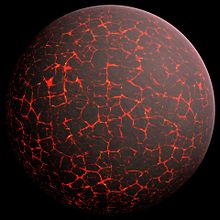Earth's outer core

Earth's outer core is a fluid layer about 2,260 km (1,400 mi) thick, composed of mostly iron and nickel that lies above Earth's solid inner core and below its mantle.[1][2][3] The outer core begins approximately 2,889 km (1,795 mi) beneath Earth's surface at the core-mantle boundary and ends 5,150 km (3,200 mi) beneath Earth's surface at the inner core boundary.[4]
Properties
This section needs expansion with: speed of convection?. You can help by adding to it. (July 2019) |
The outer core of Earth is liquid, unlike its inner core, which is solid.[5] Evidence for a fluid outer core includes seismology which shows that seismic shear-waves are not transmitted through the outer core.[6] Although having a composition similar to Earth's solid inner core, the outer core remains liquid as there is not enough pressure to keep it in a solid state.
Seismic inversions of body waves and normal modes constrain the radius of the outer core to be 3483 km with an uncertainty of 5 km, while that of the inner core is 1220±10 km.[7]: 94
Estimates for the temperature of the outer core are about 3,000–4,500 K (2,700–4,200 °C; 4,900–7,600 °F) in its outer region and 4,000–8,000 K (3,700–7,700 °C; 6,700–14,000 °F) near the inner core.[8] Modeling has shown that the outer core, because of its high temperature, is a low-viscosity fluid that convects turbulently.[8] The dynamo theory sees eddy currents in the nickel-iron fluid of the outer core as the principal source of Earth's magnetic field. The average magnetic field strength in Earth's outer core is estimated to be 2.5 millitesla, 50 times stronger than the magnetic field at the surface.[9][10]
As Earth's core cools, the liquid at the inner core boundary freezes, causing the solid inner core to grow at the expense of the outer core, at an estimated rate of 1 mm per year. This is approximately 80,000 tonnes of iron per second.[11]
Light elements of Earth's outer core
Composition
Earth's outer core cannot be entirely constituted of iron or iron-nickel
Constraints
Accretion

The variety of light elements present in Earth's outer core is constrained in part by Earth's accretion.[16] Namely, the light elements contained must have been abundant during Earth's formation, must be able to partition into liquid iron at low pressures, and must not volatilize and escape during Earth's accretionary process.[14][16]
CI chondrites
CI chondritic meteorites are believed to contain the same planet-forming elements in the same proportions as in the early Solar System,[14] so differences between CI meteorites and BSE can provide insights into the light element composition of Earth's outer core.[20][14] For instance, the depletion of silicon in BSE compared to CI meteorites may indicate that silicon was absorbed into Earth's core; however, a wide range of silicon concentrations in Earth's outer and inner core is still possible.[14][21][22]
Implications for Earth's accretion and core formation history
Tighter constraints on the concentrations of light elements in Earth's outer core would provide a better understanding of Earth's accretion and core formation history.[14][19][23]
Consequences for Earth's accretion
Models of Earth's accretion could be better tested if we had better constraints on light element concentrations in Earth's outer core.[14][23] For example, accretionary models based on core-mantle element partitioning tend to support proto-Earths constructed from reduced, condensed, and volatile-free material,[14][19][23] despite the possibility that oxidized material from the outer Solar System was accreted towards the conclusion of Earth's accretion.[14][19] If we could better constrain the concentrations of hydrogen, oxygen, and silicon in Earth's outer core, models of Earth's accretion that match these concentrations would presumably better constrain Earth’s formation.[14]
Consequences for Earth's core formation

The depletion of
In another example, the possible presence of hydrogen in Earth's outer core suggests that the accretion of Earth’s water[14][27][28] was not limited to the final stages of Earth's accretion[23] and that water may have been absorbed into core-forming metals through a hydrous magma ocean.[14][29]
Implications for Earth's magnetic field

References
- ^ "Earth's Interior". Science & Innovation. National Geographic. 18 January 2017. Archived from the original on May 6, 2017. Retrieved 14 November 2018.
- ^ Sue, Caryl (2015-08-17). Evers, Jeannie (ed.). "Core". National Geographic Society. Retrieved 2022-02-25.
- S2CID 128528504.
- ISSN 0084-6597.
- ISBN 978-1-4832-8212-1.
- ISSN 1365-246X.
- ISBN 9780875908519.
- ^ S2CID 205003051.
- ^ Staff writer (17 December 2010). "First Measurement Of Magnetic Field Inside Earth's Core". Science 2.0. Retrieved 14 November 2018.
- S2CID 4431270.
- doi:10.1038/ngeo1083.
- ^ .
- .
- ^ S2CID 237272150.
- ^ S2CID 8942975.
- ^ ISSN 0031-9201.
- ^ S2CID 213919815.
- ^ PMID 26932596.
- ^ ISSN 0012-821X.
- S2CID 128528504.
- S2CID 1892924.
- S2CID 20744455.
- ^ S2CID 37592339.
- ^ PMID 26392555.
- ^ ISSN 0016-7037.
- ISSN 0012-821X.
- S2CID 55107839.
- S2CID 10257401.
- PMID 33976113.
- ^ PMID 10856207.
